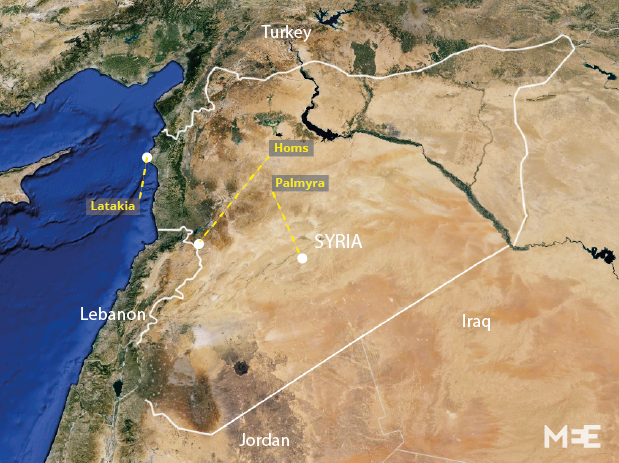IS seizes full control of Syria's Palmyra

The Islamic State (IS) has seized full control of the ancient Syrian city of Palmyra, raising fears that the world heritage site could face destruction.
In a statement issued on Twitter, IS said it took Palmyra "after the collapse of the Nusayri regime's forces and their retreat, leaving behind them large numbers of dead that have filled the battle grounds" referring to the Syrian government by the derogatory term "Nusayri"
The victory also means IS now controls more than half of Syria, though large swathes of territory are desert.
The Syrian Observatory for Human Rights told AFP that government troops had pulled back from positions in and around Palmyra, including from an army intelligence outpost, a military airport and a prison which IS captured overnight.
More than 100 government troops were killed during the clashes which left IS in control.
IS began their offensive on the ancient world heritage site of Palmyra began on 13 May, and has since left more than 350 people dead.
Amateur footage released on social media on Thursday appeared to show IS supporters burning a portrait of Syrian President Bashar al-Assad:
Mohammad, an activist originally from the modern town, told AFP that the city was suffering from water shortages and intermittent electricity.
"A large number of people from the city's north have been displaced into other neighbourhoods. Some are sleeping in the streets," he said.
Activists in the town said on Wednesday that residents had been prevented from entering the government-held hospital for seven consecutive days.
On Monday, IS seized two gas fields north of Palmyra that the government had been using to generate electricity for areas under its control.
The city is also strategically located at the crossroads of key highways leading west to Damascus and Homs, and east to Iraq.
Many have also feared that IS could begin the destruction of Palmyra, as part of their ideological opposition to idolatry which has seen them destroy the historical cities of Nimrud and Hatra.
"The (Islamic State) terrorist attack on Palmyra is to take revenge on Syrian society and civilization," Syria's antiquities chief told state news agency SANA.
UNESCO, who designated the site a world heritage site, have reacted with alarm to the fighting around Palmyra and have called on the international community to prevent its destruction.
Commentators have already expressed incredulity at the the failure of the US-led anti-IS coalition to strike against IS targets during the fighting.
“Where are these coalition attacks?" said Randa Slim, an expert with the Middle East Institute in Washington, speaking to McClatchy. "In order to get to Palmyra you have to drive through open desert. There is nothing but open desert. Couldn’t they see them from the air?”
“They could have picked up the trucks. There is nowhere for them to hide.”
Residents of Palmyra told Middle East Eye that they feared the international consequences of an IS takeover of the area.
"We are not afraid of IS," said one inhabitant, Tareq Ahmad. "We are afraid that if ISIS take control, then Assad will bomb us, and the Americans."
Another resident, Saleh Dukhan, agreed with the sentiment.
"We are afraid of both sides taking revenge," he told MEE. "If IS take control then they will take revenge on the people for siding with the regime. If the regime takes control they will take revenge on the people for siding with IS."
"They will behead people in the streets."
He said there were over 50,00 people in Palmyra, and thousands of displaced people from Deir El-Zor and Raqqa, who already fled IS there.
"I am so anxious," he said. "I don't care who controls it, just we don't want a long battle."
"There are people who are caring about the ruins. Who cares about the ruins? There are civilians here."
US-led airstrikes killed two civilians
Also Thursday, the US acknowledged that coalition airstrikes had killed two civilians in Syria, in the first such admission since the air campaign started.
"We regret the unintentional loss of lives," Lieutenant General James Terry, head of the US-led air campaign against IS, said in a statement, citing the results of an investigation.
The air strikes on 5-6 November last year were targeting members of the Khorasan group, an offshoot of al-Qaeda, in Harim City, according to the inquiry's conclusions.
"The strikes were designed to destroy targets utilized by Khorasan group-affiliated extremists to meet and manufacture explosives," the report said.
But the bombing killed two children - including the daughter of a militant - and caused "minor injuries" to two civilian workers who lived near the buildings that were targeted, it said.
In assessments prior to the air raid, there were no reports that children could be in the area, the probe concluded.
The airstrikes were carried out in accordance with extensive rules designed to avoid civilian deaths and the targets were deemed "valid military targets", it said.
The report found no wrongdoing or negligence by military forces overseeing or carrying out the strikes.
Human rights groups have alleged dozens of civilians have been killed in various airstrikes on extremists in Syria and Iraq.
Middle East Eye propose une couverture et une analyse indépendantes et incomparables du Moyen-Orient, de l’Afrique du Nord et d’autres régions du monde. Pour en savoir plus sur la reprise de ce contenu et les frais qui s’appliquent, veuillez remplir ce formulaire [en anglais]. Pour en savoir plus sur MEE, cliquez ici [en anglais].





